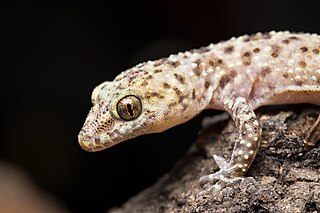
Hemidactylus is a genus of the common gecko family, Gekkonidae. It has 195 described species, newfound ones being described every few years. These geckos are found in all the tropical regions of the world, extending into the subtropical parts of Africa and Europe. They excel in colonizing oceanic islands by rafting on flotsam, and are for example found across most of Polynesia. In some archipelagoes, cryptic species complexes are found. Geckos like to live in and out of houses. They have been introduced to many areas around the world.

The Oriental leaf-toed gecko, also known commonly as the Asian smooth gecko, Bowring's gecko, Bowring's smooth gecko, and the Sikkimese dark-spotted gecko, is a species of lizard in the family Gekkonidae. The species is native to East Asia.

Hemidactylus brookii, also known commonly as Brooke's house gecko and the spotted house gecko, is a widespread species of lizard in the family Gekkonidae.

The Indo-Pacific gecko, also known commonly as Garnot's house gecko, fox gecko, and the Assam greyish brown gecko, is a species of lizard in the family Gekkonidae. The species is found in India, across Southeast Asia, Australia, and throughout Polynesia. Adults are about 4 to 5 in in total length. They are seen as dark gray or brown with light markings in daylight and a pale, translucent colour at night. The belly is orange or yellow. The head has a long, narrow snout, hence the name fox gecko. The flattened tail has a row of spiny scales on the lateral edges. The species is parthenogenic – all individuals are female and lay eggs that hatch without requiring male fertilisation.

Cyrtodactylus jeyporensis, also known as the Jeypore Indian gecko, the Jeypore ground gecko, or the Patinghe Indian gecko, is an endangered species of gecko found in India, which was until recently considered extinct. Described from a single specimen in 1877, it was rediscovered in 2010 in the Eastern Ghats of Odisha state, India.

The scaly gecko is a species of nocturnal, terrestrial, insectivorous gecko found in South India and northern Sri Lanka. This species was first discovered in the coastal sand dunes of Ramanathapuram in Tamil Nadu. Subsequently, it was incorrectly identified and only recently, elaborate descriptions and molecular data are available, enabling a proper identification.

The Mediterranean house gecko is a species of house gecko native to the Mediterranean region, from which it has spread to many parts of the world including parts of East Africa, South America, the Caribbean, and the Southern and Southeastern United States. It is commonly referred to as the Turkish gecko as represented in its Latin name and also as the moon lizard because it tends to emerge in the evening.

The tropical house gecko, also called commonly the Afro-American house gecko and the cosmopolitan house gecko, is a species of house gecko, a lizard in the family Gekkonidae. The species is native to sub-Saharan Africa. However, it is also found in North, Central and South America and the Caribbean, where it has been inadvertently introduced by humans.
Cochran's croaking gecko, also commonly known as Cochran's Caribbean gecko and the Navassa gecko, is a species of lizard in the family Sphaerodactylidae. The species was described in 1931 by Chapman Grant and named after notable American herpetologist and artist Doris Mable Cochran. The species received one of its common names from the loud croaking call of the male during the mating period.

Astylosternus batesi is a species of frog in the family Arthroleptidae. It is found in Cameroon south of Sanaga River, Equatorial Guinea, Gabon, southwestern Central African Republic, the Republic of the Congo, and the extreme western Democratic Republic of the Congo (Mayombe). The specific name batesi honours George Latimer Bates, an American naturalist. However, its vernacular name is Benito River night frog, apparently in reference to its type locality, Benito River in Equatorial Guinea.

The carrot-tail viper gecko is a species of gecko. It is found in Iran, Pakistan and possibly India, although the Indian records are questionable.
Blanford's pipe snake or lined pipe snake, is a species of snake in the family Cylindrophiidae endemic to Indonesia.
Hemidactylus kyaboboensis is a species of forest geckos from Ghana and Togo. Its type locality is Kyabobo National Park, to which its specific name refers. It is the sister species of Hemidactylus fasciatus.
Hemidactylus eniangii is a species of forest gecko found in Nigeria and northern Cameroon. It inhabits lowland tropical moist forest at elevations of 10–960 m (33–3,150 ft) above sea level and can be locally very common.
The Bioko leaf-toed gecko is a species of forest geckos from Bioko Island. It occurs in the coastal areas of the island and it has also been found in a forest immediately adjacent to the beach.
Hemidactylus bavazzanoi, also known commonly as Bavazzano's gecko, the Somali banded gecko, and the Somali leaf-toed gecko, is a species of lizard in the family Gekkonidae. The species is native to eastern Africa.

The banded leaf-toed gecko is a species of gecko. It is endemic to West Africa west of the Dahomey Gap, from southern Guinea to Togo.

The Guinea leaf-toed gecko is a species of gecko. It is found in West Africa between Guinea in the west and Nigeria east, and further east and south in Central Africa, in Cameroon, Gabon, and the Democratic Republic of the Congo. The Reptile Database also includes the Central African Republic as possible extension of its range.
Kamdem Toham's gecko is a species of gecko, a lizard in the family Gekkonidae. The species is native to western Central Africa.
Hemidactylus ituriensis is a species of gecko. As currently known, it is endemic to northeastern Democratic Republic of Congo, although its true range probably extends eastwards to Uganda and Kenya. It belongs to the "Hemidactylus fasciatus species group".













